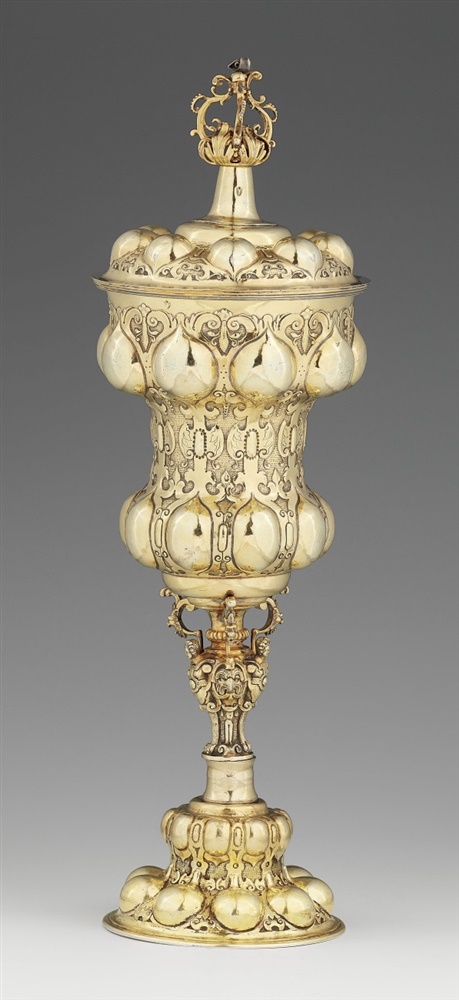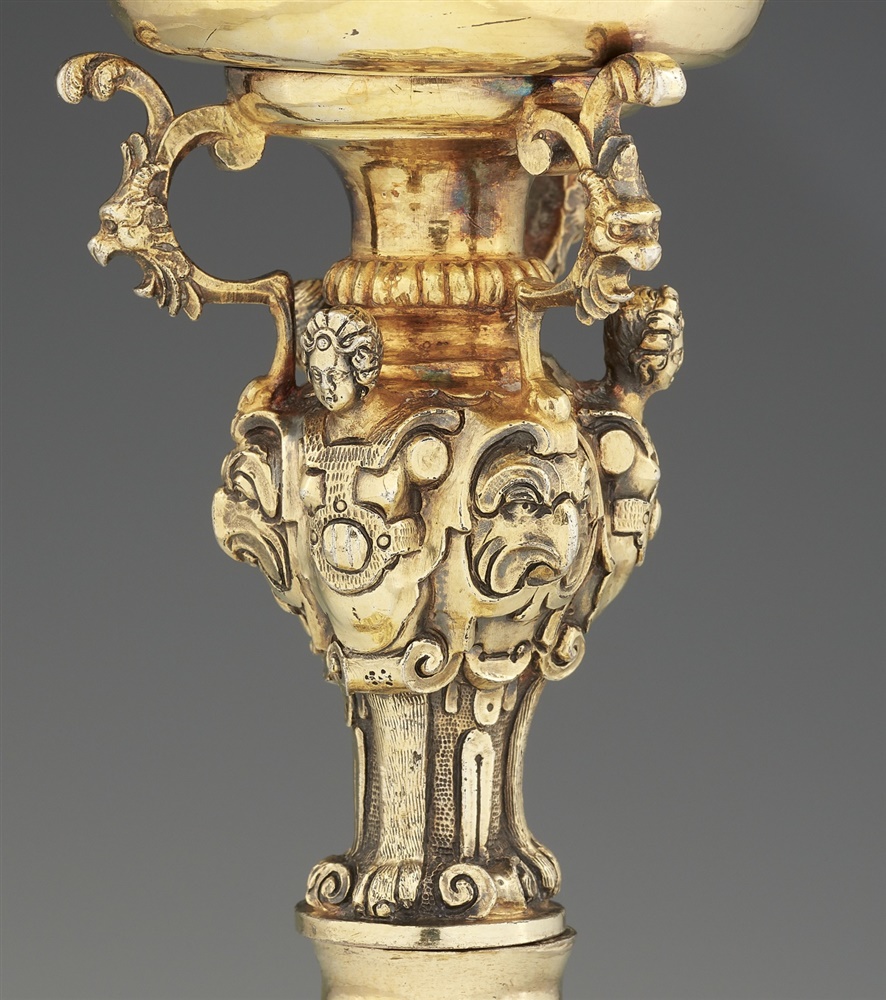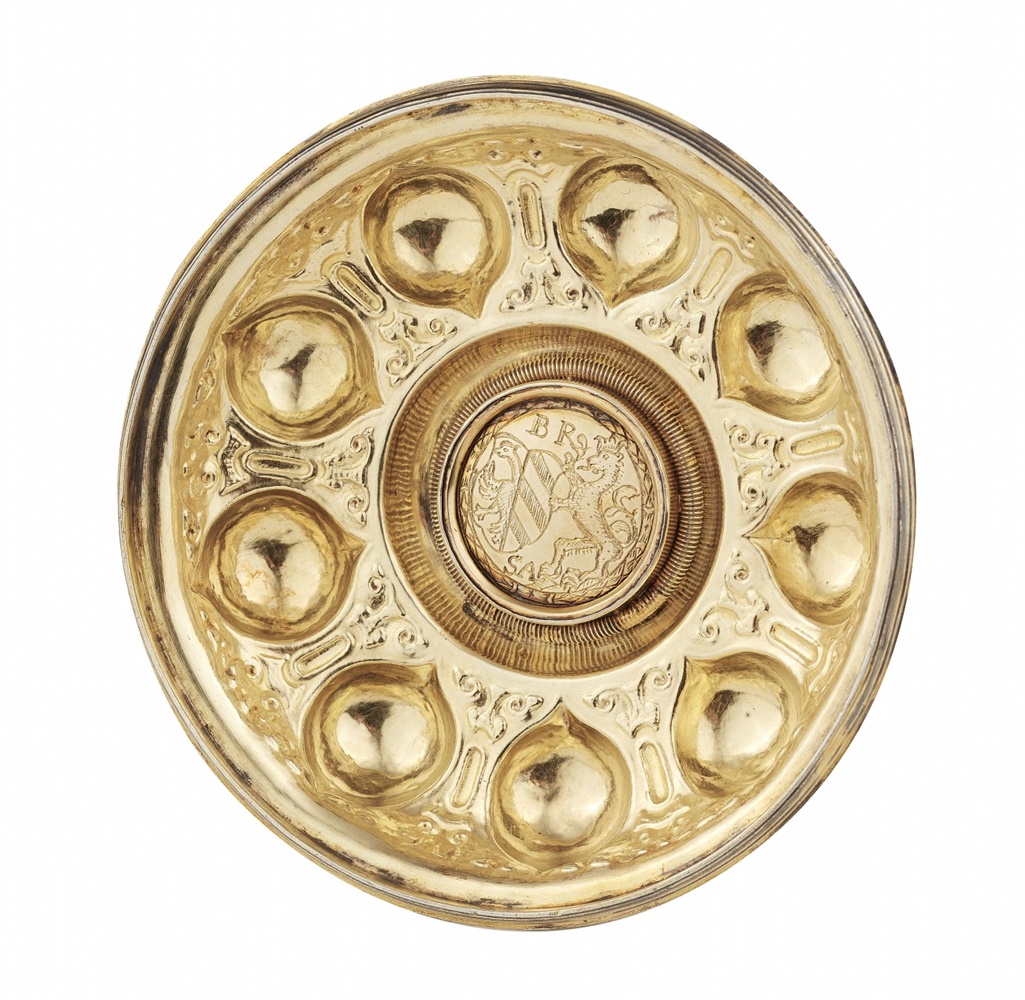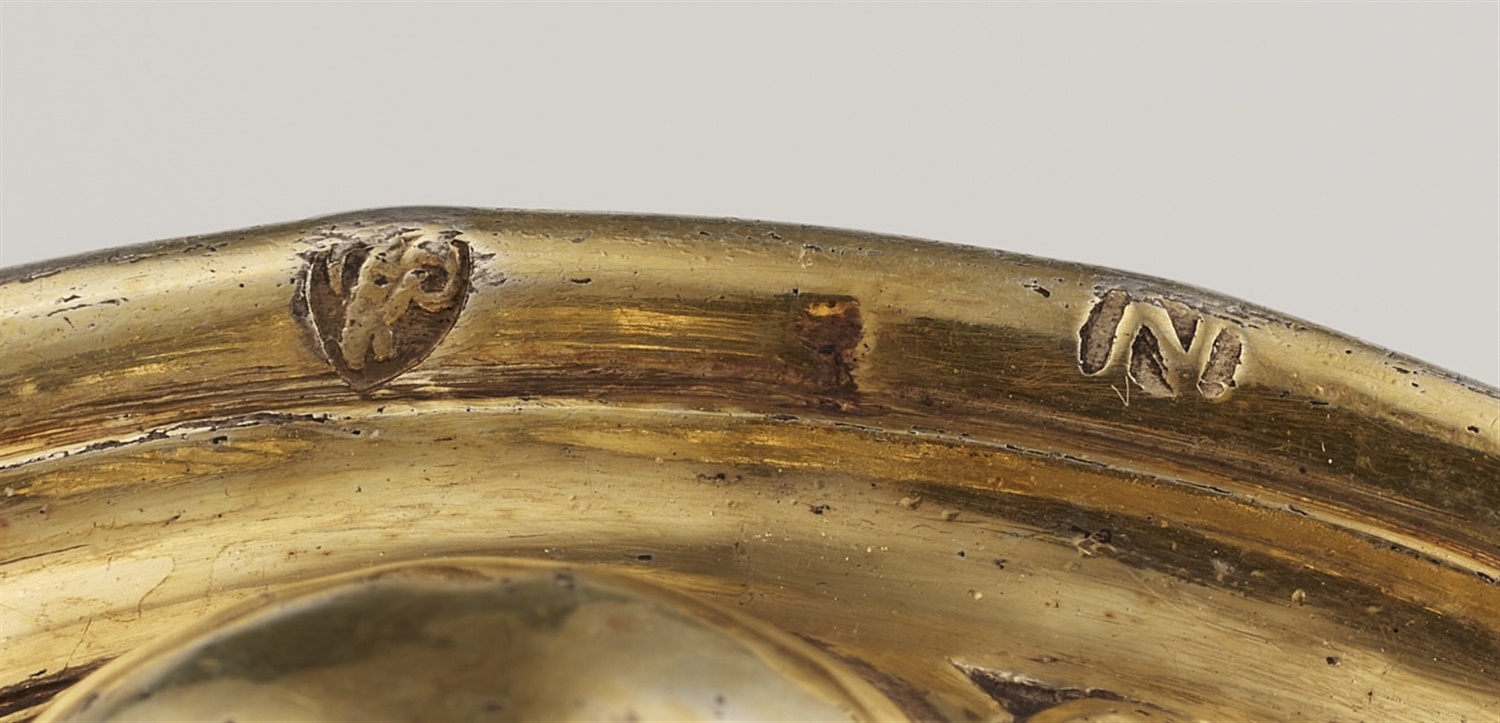714
A Nuremberg Renaissance silver gobletSilver-gilt goblet with a gadrooned base supporting a waisted
Nürnberger Renaissance-Pokal
Silber; vergoldet. Auf neunfach gebuckeltem, eingeschnürtem Fuß der fein ziselierte Balusterschaft mit drei aufwändig gestalteten Volutenspangen über weiblichen Hermen auf Tatzenfüßen. Die eingeschnürte Kuppa mit zwei Reihen großer getriebener Buckel zwischen Roll- und Beschlagwerk. Der wenig aufgewölbte Deckel mit entsprechendem Dekor und einer Krone aus Volutenspangen und Zierblattwerk; im Innern eine vergoldete Plaque mit dem gravierten, von einem Löwen gehaltenen Wappen der Stadt Betzenstein bei Nürnberg mit den Initialen "BR" und "SA". Marken: BZ Nürnberg um 1590 - 1600, MZ Hans Petzolt (1578/80 - 1633, GNM Nr. BZ10, 640b), Tremolierstich H 35 cm, Gewicht 551 g
Nürnberg, Hans Petzolt, um 1590 - 1600.
Hans Petzolt war einer der produktivsten, meistgefragten und künstlerisch befähigtsten Nürnberger Goldschmiede der Jahrzehnte um 1600. Kennzeichnend für seine Arbeiten sind die aufwändigen Appliken und ornamentalen Gussteile, wie wir sie auch hier am Nodus des Schafts erkennen. Zu Petzolts Auftraggebern zählten beispielsweise Kaiser Rudolf II. in Prag oder Bayernherzog Wilhelm V.
Offensichtlich wurde sein Können zeit seines Lebens auch vom Nürnberger Rat geschätzt, denn er belieferte ihn ab 1581 über ein halbes Jahrhundert lang mit zahlreichen Arbeiten, die oft als Geschenke an hochgestellte Empfänger dienten. Das gravierte Wappen der Stadt Betzenburg im Deckel der vorliegenden Arbeit spricht dafür, dass es sich auch hierbei um ein solches Ratsgeschenk handeln könnte.
Provenienz
Italienische Privatsammlung.
Literatur
Vgl. Petzolts Deckelpokal für die Nürnberger Patrizierfamilie Kress, abgebildet im Kat. Wenzel Jamnitzer und die Nürnberger Goldschmiedekunst 1500 - 1700, München 1985, Nr. 70. Vgl. auch den Fortunapokal des Meisters im Bayerischen Nationalmuseum, sowie seinen Dianapokal im Kunstgewerbemuseum Berlin, beide abgebildet im Kat. GNM Nr. 332, 352. Ein mit unserem nahezu identischer Pokal befindet sich in der Sammlung Rudolf-August Oetker, abgebildet im Kat. Faszination des Sammelns, München 2012, Nr. 2.
A Nuremberg Renaissance silver goblet
Silver-gilt goblet with a gadrooned base supporting a waisted and finely chased baluster-form shaft with scroll motifs above three female herms. The waisted cuppa with gadrooned motifs amid scrollwork and strapwork. The corresponding lid with a scrolling finial and a gilt plaque engraved with the coat of arms of Betzenstein near Nuremberg with the initials “BR” and “SA” to the interior. Marken: BZ Nürnberg um 1590 - 1600, MZ Hans Petzolt (1578/80 - 1633, GNM Nr. BZ10, 640b), Tremolierstich H 35 cm, weight 551 g.
Marks of Hans Petzolt, around 1590 - 1600.
Hans Petzolt was one of the most productive, popular and talented Nuremberg goldsmiths of around 1600. His works are characterised by their ornate appliques and cast motifs, such as the shaft node seen here. Petzold's patrons included Emperor Rudolf II of Prague and the Bavarian Duke Wilhelm V. His works were apparently also highly sough-after by the council of Nuremberg. For nearly half a century from 1581 onwards, he provided them with numerous items, many of which were intended as gifts for high-ranking recipients. The engraved coat of arms of the city of Betzenburg in the lid of this piece indicates that it too may have been given as a gift by the council.
Provenance
Italian private collection.
Literature
Cf. a chalice by Petzolt made for the Nuremberg patrician family Kress illus. in cat.: Wenzel Jamnitzer und die Nürnberger Goldschmiedekunst 1500 - 1700, Munich 1985, no. 70. Cf. Also the fortuna goblet by this maker in the Bayerisches Nationalmuseum and the Diana goblet in the Kunstgewerbemuseum Berlin, both illus. in cat.:GNM no. 332, 352. A goblet almost identical to the present work is housed in the collection of Rudolf-August Oetker, illus. in cat.: Faszination des Sammelns, Munich 2012, no. 2.
Nürnberger Renaissance-Pokal
Silber; vergoldet. Auf neunfach gebuckeltem, eingeschnürtem Fuß der fein ziselierte Balusterschaft mit drei aufwändig gestalteten Volutenspangen über weiblichen Hermen auf Tatzenfüßen. Die eingeschnürte Kuppa mit zwei Reihen großer getriebener Buckel zwischen Roll- und Beschlagwerk. Der wenig aufgewölbte Deckel mit entsprechendem Dekor und einer Krone aus Volutenspangen und Zierblattwerk; im Innern eine vergoldete Plaque mit dem gravierten, von einem Löwen gehaltenen Wappen der Stadt Betzenstein bei Nürnberg mit den Initialen "BR" und "SA". Marken: BZ Nürnberg um 1590 - 1600, MZ Hans Petzolt (1578/80 - 1633, GNM Nr. BZ10, 640b), Tremolierstich H 35 cm, Gewicht 551 g
Nürnberg, Hans Petzolt, um 1590 - 1600.
Hans Petzolt war einer der produktivsten, meistgefragten und künstlerisch befähigtsten Nürnberger Goldschmiede der Jahrzehnte um 1600. Kennzeichnend für seine Arbeiten sind die aufwändigen Appliken und ornamentalen Gussteile, wie wir sie auch hier am Nodus des Schafts erkennen. Zu Petzolts Auftraggebern zählten beispielsweise Kaiser Rudolf II. in Prag oder Bayernherzog Wilhelm V.
Offensichtlich wurde sein Können zeit seines Lebens auch vom Nürnberger Rat geschätzt, denn er belieferte ihn ab 1581 über ein halbes Jahrhundert lang mit zahlreichen Arbeiten, die oft als Geschenke an hochgestellte Empfänger dienten. Das gravierte Wappen der Stadt Betzenburg im Deckel der vorliegenden Arbeit spricht dafür, dass es sich auch hierbei um ein solches Ratsgeschenk handeln könnte.
Provenienz
Italienische Privatsammlung.
Literatur
Vgl. Petzolts Deckelpokal für die Nürnberger Patrizierfamilie Kress, abgebildet im Kat. Wenzel Jamnitzer und die Nürnberger Goldschmiedekunst 1500 - 1700, München 1985, Nr. 70. Vgl. auch den Fortunapokal des Meisters im Bayerischen Nationalmuseum, sowie seinen Dianapokal im Kunstgewerbemuseum Berlin, beide abgebildet im Kat. GNM Nr. 332, 352. Ein mit unserem nahezu identischer Pokal befindet sich in der Sammlung Rudolf-August Oetker, abgebildet im Kat. Faszination des Sammelns, München 2012, Nr. 2.
A Nuremberg Renaissance silver goblet
Silver-gilt goblet with a gadrooned base supporting a waisted and finely chased baluster-form shaft with scroll motifs above three female herms. The waisted cuppa with gadrooned motifs amid scrollwork and strapwork. The corresponding lid with a scrolling finial and a gilt plaque engraved with the coat of arms of Betzenstein near Nuremberg with the initials “BR” and “SA” to the interior. Marken: BZ Nürnberg um 1590 - 1600, MZ Hans Petzolt (1578/80 - 1633, GNM Nr. BZ10, 640b), Tremolierstich H 35 cm, weight 551 g.
Marks of Hans Petzolt, around 1590 - 1600.
Hans Petzolt was one of the most productive, popular and talented Nuremberg goldsmiths of around 1600. His works are characterised by their ornate appliques and cast motifs, such as the shaft node seen here. Petzold's patrons included Emperor Rudolf II of Prague and the Bavarian Duke Wilhelm V. His works were apparently also highly sough-after by the council of Nuremberg. For nearly half a century from 1581 onwards, he provided them with numerous items, many of which were intended as gifts for high-ranking recipients. The engraved coat of arms of the city of Betzenburg in the lid of this piece indicates that it too may have been given as a gift by the council.
Provenance
Italian private collection.
Literature
Cf. a chalice by Petzolt made for the Nuremberg patrician family Kress illus. in cat.: Wenzel Jamnitzer und die Nürnberger Goldschmiedekunst 1500 - 1700, Munich 1985, no. 70. Cf. Also the fortuna goblet by this maker in the Bayerisches Nationalmuseum and the Diana goblet in the Kunstgewerbemuseum Berlin, both illus. in cat.:GNM no. 332, 352. A goblet almost identical to the present work is housed in the collection of Rudolf-August Oetker, illus. in cat.: Faszination des Sammelns, Munich 2012, no. 2.
Decorative Kunst
Auktionsdatum
Ort der Versteigerung
Für Kunsthaus Lempertz Versandinformtation bitte wählen Sie +49 (0)221 9257290.
Wichtige Informationen
Nothing important.
AGB
standard | standard
Conditions of Sale
1. The art auction house, Kunsthaus Lempertz KG (henceforth referred to as Lempertz), conducts public auctions in terms of § 383 paragraph 3 sentence 1 of the Civil Code as commissioning agent on behalf of the accounts of submitters, who remain anonymous. With regard to its auctioneering terms and conditions drawn up in other languages, the German version remains the official one.
2. The auctioneer reserves the right to divide or combine any catalogue lots or, if it has special reason to do so, to offer any lot for sale in an order different from that given in the catalogue or to withdraw any lot from the sale.
3. All lots put up for sale may be viewed and inspected prior to the auction. The catalogue specifications and related specifications appearing on the internet, which have both been compiled in good conscience, do not form part of the contractually agreed to conditions. These specifications have been derived from the status of the information available at the time of compiling the catalogue. They do not serve as a guarantee in legal terms and their purpose is purely in the information they provide. The same applies to any reports on an item’s condition or any other information, either in oral or written form. Certificates or certifications from artists, their estates or experts relevant to each case only form a contractual part of the agreement if they are specifically mentioned in the catalogue text. The state of the item is generally not mentioned in the catalogue. Likewise missing specifications do not constitute an agreement on quality. All items are used goods.
4. Warranty claims are excluded. In the event of variances from the catalogue descriptions, which result in negation or substantial diminution of value or suitability, and which are reported with due justification within one year after handover, Lempertz nevertheless undertakes to pursue its rights against the seller through the courts; in the event of a successful claim against the seller, Lempertz will reimburse the buyer only the total purchase price paid. Over and above this, Lempertz undertakes to reimburse its commission within a given period of three years after the date of the sale if the object in question proves not to be authentic.
5. Claims for compensation as the result of a fault or defect in the object auctioned or damage to it or its loss, regardless of the legal grounds, or as the result of variances from the catalogue description or statements made elsewhere are excluded unless Lempertz acted with wilful intent or gross negligence; the liability for bodily injury or damages caused to health or life remains unaffected. In other regards, point 4 applies.
6. Submission of bids. Bids in attendance: The floor bidder receives a bidding number on presentation of a photo ID. Lempertz reserves the right to grant entry to the auction. If the bidder is not known to Lempertz, registration must take place 24 hours before the auction is due to begin in writing on presentation of a current bank reference. Bids in absentia: Bids can also be submitted either in writing, telephonically or via the internet. The placing of bids in absentia must reach Lempertz 24 hours before the auction to ensure the proper processing thereof. The item must be mentioned in the bid placed, together with the lot number and item description. In the event of ambiguities, the listed lot number becomes applicable. The placement of a bid must be signed by the applicant. The regulations regarding revocations and the right to return the goods in the case of long distance agreements (§ 312b-d of the Civil Code) do not apply. Telephone bids: Establishing and maintaining a connection cannot be vouched for. In submitting a bid placement, the bidder declares that he agrees to the recording of the bidding process. Bids via the internet: They will only be accepted by Lempertz if the bidder registered himself on the internet website beforehand. Lempertz will treat such bids in the same way as bids in writing.
7. Carrying out the auction: The hammer will come down when no higher bids are submitted after three calls for a bid. In extenuating circumstances, the auctioneer reserves the right to bring down the hammer or he can refuse to accept a bid. If several individuals make the same bid at the same time, and after the third call, no higher bid ensues, then the ticket becomes the deciding factor. The auctioneer can retract his acceptance of the bid and auction the item once more if a higher bid that was submitted on time, was erroneously overlooked and immediately queried by the bidder, or if any doubts regarding its acceptance arise. Written bids are only played to an absolute maximum by Lempertz if this is deemed necessary to outbid
another bid. The auctioneer can bid on behalf of the submitter up to the agreed limit, without revealing this and irrespective of whether other bids are submitted. Even if bids have been placed and the hammer has not come down, the auctioneer is only liable to the bidder in the event of premeditation or gross negligence.
8. Once a lot has been knocked down, the successful bidder is obliged to buy it. If a bid is accepted conditionally, the bidder is bound by his bid until four weeks after the auction unless he immediately withdraws from the conditionally accepted bid. From the fall of the hammer, possession and risk pass directly to the buyer, while ownership passes to the buyer only after full payment has been received.
9. Up to a hammer price of € 400,000 a premium of 24 % calculated on the hammer price plus 19 % value added tax (VAT) calculated on the premium only is levied. The premium will be reduced to 20 % (plus VAT) on any amount surpassing € 400,000 (margin scheme). On lots which are characterized by N, an additional 7 % for import tax will be charged. On lots which are characterized by an D, 35% is calculated on the hammer price (24% buyer´s premium + 19% VAT on the premium only + import tax). 31% is calculated on the amount surpassing € 400.000. The D objects contain all taxes, and tehy can not be carried away immediately. On lots which are characterized by an R, the buyer shall pay a premium of 24 % on the hammer price up to € 400,000 and 20 % on the surpassing amount; onto this (hammer price and premium) the statutory VAT of 19 % will be added (regular scheme). Exports to third (i.e. non-EU) countries will be exempt from VAT, and so will be exports made by companies from other EU member states if they state their VAT identification number. For original works of art, whose authors are either still alive or died after 31.12.1948, a charge of 1.8 % on the hammer price will be levied for the droit de suite. The maximum charge is € 12,500. If a buyer exports an object to a third country personally, the VAT will be refunded, as soon as Lempertz receives the export and import papers. All invoices issued on the day of auction or soon after remain under provision.
10. Successful bidders attending the auction in person shall forthwith upon the purchase pay to Lempertz the final price (hammer price plus premium and VAT) in Euro. Payments by foreign buyers who have bid in writing or by proxy shall also be due forthwith upon the purchase, but will not be deemed to have been delayed if received within ten days of the invoice date. Bank transfers are to be exclusively in Euros. The request for an alteration of an auction invoice to a person other than the bidder has to be made immediately after the auction. Lempertz however reserves the right to refuse such a request if it is deemed appropriate.
11. In the case of payment default, Lempertz will charge 1% interest on the outstanding amount of the gross price per month.. If the buyer defaults in payment, Lempertz may at its discretion insist on performance of the purchase contract or, after allowing a period of grace, claim damages for non-performance. In the latter case, Lempertz may determine the amount of the damages by putting the lot or lots up for auction again, in which case the defaulting buyer will bear the amount of any reduction in the proceeds compared with the earlier auction, plus the cost of resale, including the premium.
12. Buyers must take charge of their purchases immediately after the auction. Once a lot has been sold, the auctioneer is liable only for wilful intent or gross negligence. Lots will not, however, be surrendered to buyers until full payment has been received. Without exception, shipment will be at the expense and risk of the buyer. Purchases which are not collected within four weeks after the auction may be stored and insured by Lempertz on behalf of the buyer and at its expense in the premises of a freight agent. If Lempertz stores such items itself, it will charge 1 % of the hammer price for insurance and storage costs.
13. As far as this can be agreed, the place of performance and jurisdiction is Cologne. German law applies; the German law for the protection of cultural goods applies; the provisions of the United Nations Convention on Contracts for the International Sale of Goods (CISG) are not applicable. Should any provision herein be wholly or partially ineffective, this will not affect the validity of the remaining provisions.
Henrik Hanstein, sworn public auctioneer
Takuro Ito, Kilian Jay von Seldeneck, auctioneers












